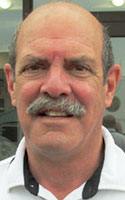Analysis of some of the key sectors of the local economy
Stories by Ken Sturtz
1. Agriculture
Some sectors have seen their sales rise dramatically, despite the pandemic

Oswego County has deep agrarian roots and today farmers produce everything from fruits, vegetables and maple syrup to meat, milk and Christmas trees.
The market value of agricultural products produced in Oswego County is more than $41 million. The number of farms has ticked down in recent years, but the county still counts more than 600 active farms, ranging from operations employing multiple people to part-time family farms.
Although farmers dealt with many challenges in 2020, some sectors — nurseries, greenhouses, Christmas tree farms — saw their sales rise dramatically, says Mark James of the New York Farm Bureau. The Farm Bureau also worked with the state to ensure the scores of farmers markets in the region were able to open for farmers to sell their products.
“One of the bright spots of the pandemic is we’re seeing more and more folks shopping locally and sourcing food from local farms,” James says.
Farmers who sold directly to consumers saw significant sales increases, likely due to shortages at supermarkets and worries about supply chain issues, says Joshua Vrooman, an agriculture community educator for Cornell Cooperative Extension of Oswego County. CSA vegetable boxes and U-pick operations also experienced major bumps in sales during the summer and fall.
Farmers were helped during the pandemic by efforts of the state Department of Agriculture and Markets, which partnered with Cooperative Extension to distribute facial masks and hand sanitizer. Vrooman says they distributed thousands of masks and gallons of hand sanitizer to farmers in the county, especially those in direct contact with consumers.
The outlook for farmers in 2021 will likely depend somewhat on who their customers are. Anyone whose main market was supplying restaurants, for example, was hit hard in 2020, says Erich Keena, an agricultural economic development specialist for Cooperative Extension. Even as restaurants have reopened, they’re not doing the same volume of business, which affects their suppliers. Farmers who saw increased sales in 2020 by selling directly to consumers will likely enjoy robust business this year.
2. Energy
Exelon power plants in Scriba produce a third of the state’s carbon-free energy
Oswego County’s energy sector is dominated by its nuclear power plants, which despite concerns about closing in recent years, continue to provide a large number of good-paying jobs.
Exelon Generation operates Nine Mile Point Nuclear Station and the James A. FitzPatrick Nuclear Power Plant, both in Scriba. Nine Mile Point Units 1 and 2 generate 1,907 megawatts, enough electricity to power more than 2 million homes. Unit 1 entered service in 1970 and Unit 2 in 1988.
The FitzPatrick plant produces 838 megawatts, enough to power 800,000 homes; it entered service in 1975.
Exelon employs more than 1,300 workers in Oswego County with an annual payroll of more than $170 million. Periodic refueling outages necessitate more than 1,300 additional workers, many of whom travel to Oswego County from out of state. For several weeks before and during outages, the influx of people gives a boost to the local economy.
Exelon says its employees at its Scriba power plants, which produce a third of the state’s carbon-free energy, worked diligently to fulfill the critical role they play in powering hospitals, regional response centers and millions of homes and essential businesses during the pandemic.
The company says it has taken precautions to keep employees and the community safe, such as completing temperature pre-screenings of all employees-contractors, allowing as many employees as possible to work from home, limiting travel, and minimizing personal contact through social distancing.
3. Healthcare
Oswego Health sees substantial growth in 2020, has played pivotal role in vaccine distribution

Throughout 2020, health care organizations have been on the front lines of protecting the community from COVID-19 and will continue to be essential in 2021 as the economy recovers.
Oswego Health’s task has been twofold, playing a key role in combatting the coronavirus as well as moving forward on several key expansion and development projects.
“We’ve been very proud as a system of the work we’ve done internally to protect our patients,” says Michael Backus, chief operating officer for Oswego Health. “We have done a remarkable job of being prepared for the pandemic.”
In particular, Backus says the hospital has worked tirelessly to educate employees of the importance of the organization’s infectious disease prevention strategies and ensure they are continually being followed by staff. That’s been important at Oswego Hospital, but also at other units in the system, such as assisted living.
Oswego Health has also led the pack on vaccinating its staff against the COVID-19 virus. Its preparation and planning were so efficient that during the vaccine’s initial rollout it used 99% of its vaccine allotment, drawing praise from the governor. Oswego Health will play a key role in vaccine distribution, among its staff and residents in its assisted living facilities as well as the public at large when the time comes through its primary care offices.
“We’re now rolling into getting those second shots to the people who had the first,” Backus says. “We’re working very hard on that. It’s the thing that’s going to turn this pandemic around.”
Oswego Health has continued to expand and enhance its specialty service offerings. It added a new orthopedic surgeon to its Center for Orthopedic Care team as well an orthopedic physician assistant and a nurse practitioner. It also added a new bariatric surgeon to its Center for Weight Loss & Surgery.
Backus says Oswego Health’s investment in specialty services makes business sense and means people no longer need to leave the community and go to Syracuse to access those services as has traditionally been the case.
“A lot of people went south for that healthcare,” he says. “There’s no reason for that. We’re able to offer that care right here.”
Oswego Health opened its new behavioral health services facility, Lakeview Center for Mental Health and Wellness, in January. The project was made possible through a $13 million grant from the state Department of Health.
The facility on East Cayuga Street in Oswego was the location of a former grocery store. The 42,000-square-foot space is designed to provide inpatient and outpatient care and includes 32 inpatient beds.
“I think that’s going to pay dividends coming out of our community,” Backus says.
Other projects by Oswego Health include resumption of renovations to the third and fourth floors of Oswego Hospital. The current rooms are being turned into 44 private patient rooms. The project is expected to be completed by the end of 2021.
Plans are also underway to renovate the Advanced Medical Services building on Route 481 in Fulton as part of a plan to expand primary care services in the community.
4. Higher Education
SUNY Oswego faces a $6.6 million shortfall in its 2020-21 budget

Deborah Stanley.
SUNY Oswego remains a major economic force in the community. In 2020, the college spent more than $76 million on employee compensation. Since 2013, its capital projects have exceeded $110 million and injected $50 million into New York’s economy.
Higher education faced challenges at nearly every turn in 2020, from financial pressure and fighting COVID-19 to finding a way to safely educate students.
“We accomplished a great deal in 2020, while also managing our response to an unprecedented global pandemic to ensure the health and safety of members of our community while striving to maintain and extend excellence in teaching and learning,” says President Deborah F. Stanley.
Last fall, amid rising cases of COVID-19, the college proactively entered a two-week pause of in-person learning and moved to fully remote learning. Most on-campus activities were suspended, including athletics, extra-curricular activities and in-person dining. College officials praised the way students responded to the pandemic restrictions, which upended traditional campus life.
“Our campus community met this challenge head on and displayed to others that when we pulled together, cared for one another and followed the rules and guidelines, we brought our positive cases down,” Stanley says.
In the midst of dealing with the pandemic, the college also faced a $6.6 million shortfall in its 2020-21 budget. Its state funding was reduced 25% and it experienced a small decrease in enrollment revenues in the fall 2020 semester. The college took a multifaceted approach to maintain its operations and financial stability. SUNY Oswego suspended or reduced hiring, put travel on hold and scoured its budget.
Despite the challenges, SUNY Oswego continued to deliver an academic curriculum to students in the spring 2020, summer 2020, fall 2020, and winter 2020 semesters through a mixture of face-to-face, online and hybrid classes.
“Our faculty and staff have shown tremendous resourcefulness in implementing the unforeseen and rapid change to remote teaching and learning,” Stanley says. “They successfully negotiated a long roster of unplanned circumstances and delivered in their full capacities to support our students and our college — they were unwavering in their dedication to student success.”
As part of its efforts to help students affected by the pandemic, in spring 2020 the college applied for and received $3.6 million in Coronavirus Aid, Relief and Economic Recovery (CARES) Act funding. It expects to receive another $3.6 million in CARES funding this year. The grant money can be used to help students pay for eligible expenses such as food, housing, course materials, technology, health care, and child care.
SUNY Oswego also created a Student Emergency Fund in 2020 to assist students with the immediate housing, food, transportation and technology needs they encountered due to the pandemic. The fund has received more than $270,000 in private donations to date.
In 2020, the college also rolled out several new academic programs. In addition to minors in sales and entrepreneurship, and business analytics, it also proposed creating a master’s degree in higher education leadership and added a new track to its master’s degree in biomedical health informatics.
As the spring semester begins, Stanley says SUNY Oswego will be guided by its “Winter and Spring Forward 2021 Plan.” It provides detailed information and guidelines including on academic instruction, weekly surveillance testing, isolation and quarantine protocols, and outbreak response and containment.
Testing students and employees weekly during the spring semester will be made easier by the college’s partnership with SUNY Upstate for virus testing and response. Between August and November 2020, students and employees received more than 22,000 COVID-19 tests.
Cayuga Community College: Working on its new Advanced Manufacturing Institute
Cayuga Community College has faced similar challenges, taking precautions for in-person learning and developing the capacity to deliver instruction remotely.
“Our students have been extremely resilient and engaged in their coursework,” says President Brian M. Durant.
Over the last year the college has developed the ability to offer both hybrid and fully remote instruction, which is more convenient for some students, but also helps other students maintain their enrollment and continue their studies. Although it’s not the same as in-person learning, Durant says the college is focused on keeping students engaged.
Cayuga Community College is also moving forward on a new workforce development project on its Fulton campus, an Advanced Manufacturing Institute. The institute will offer state-of-the-art learning opportunities and hands-on training, helping the local workforce enhance their expertise and ensure that regional industry leaders have a talented pool of potential employees.
The college is working with local manufacturers, the county Industrial Development Agency and the Cayuga Community College Foundation on the 7,500-square-foot facility. Renovations will begin this year.
5. Manufacturing
Overall employment declined significantly in 2020

Manufacturing continues to be a key driver of the economy throughout much of Upstate New York and in Oswego County.
“This year was a challenge, but still overall a significant amount of manufacturing activity,” says Randy Wolken, president and CEO of the Manufacturers Association of Central New York.
Manufacturing employment in Central New York declined significantly in 2020, but things are already beginning to recover, Wolken says. Part of the challenge is that the economy hasn’t been fully open for a while, which reduces both demand and opportunity for the manufacturing sector.
An upside for manufacturers last year during the pandemic was the fact that many were deemed essential businesses. With the proper precautions, many manufacturers remained open.
Novelis, which employs 1,200 people in Central New York and is the largest manufacturer in Oswego County, experienced disruption in its operations in 2020. In response to temporary shutdowns by American automakers, Novelis temporarily ramped down some production at its plant in Scriba. During this period, it continued to produce aluminum for the beverage can and specialty markets.
Novelis kept all employees whole and resumed full capacity operations at its plant at the beginning of the summer.

“Our ability to continue essential operations was in big part thanks to the agility from our teams to adjust workflow, operations, schedules and adhere to new safety requirements,” says Jeff Cruse, plant manager. “Equally important was our commitment to teamwork and finding resourceful ways to share information.”
Novelis is continuing to provide aluminum to Ford for its F-150 pickup truck and it is benefiting from increased demand for aluminum cans. Despite the pandemic, the company has continued collaborating with partners at CiTi Boces to build out the pipeline of future STEM and manufacturing professionals through its P-Tech program, which graduated its first class.
Some areas of manufacturing, such as automotive, will continue to recover in 2021, Wolken says. Others, such as those in food processing or those making home goods, actually saw growth throughout 2020.
“I think what we’ll see is an incremental recovery throughout 2021 especially as vaccines flow more regularly,” Wolken says.
Additionally, Wolken says the state and federal government are likely to make investments in infrastructure and the green economy, which will benefit manufacturing.
6. Nonprofit
Financial hurdles hitting nonprofits when the demands for their services is high

From human service agencies and colleges to hospitals and museums, nonprofits are a massive piece of the economy. Nonprofits employ nearly 20% of the workforce in the state.
Thousands of people across Central New York work in the nonprofit sector and many more benefit from their work, whether that’s feeding the hungry, providing medical care or preserving cultural treasures.
But nonprofits have endured unprecedented strain throughout the pandemic as the demand for their services has skyrocketed and many of their funding sources have dried up.
“If you think about it from a business perspective, you’ve got challenges on both sides of the ledger” says Peter Dunn, president and CEO of the Central New York Community Foundation. “There’s a multifaceted challenge that’s impacted the nonprofit service sector in our region.”
Many organizations that rely on government contracts or reimbursements to provide their services have experienced problems due to state and local government facing severe fiscal challenges. Organizations both large and small have experienced delays being paid or have seen funding cut, Dunn says.
Nonprofits that rely on fundraising events and private donations for a significant portion of their funding have generally struggled, too. Donor dollars have been stretched thin this past year and the pandemic forced the cancelation of most fundraising events.
Although some organizations found ways to successfully reinvent their fundraisers, often by turning them into virtual events, many more organizations simply lost that revenue they normally would have been able to plan on, Dunn says. The impact has also varied by organization. Some have been better able to weather the funding challenges than others.
All these financial hurdles are occurring at the same time that any nonprofits, especially health and human service agencies, have experienced increased demand for their services.
“Nonprofits are an economic engine and if their revenue models are undermined, that’s going to affect their ability to staff the services they provide” Dunn says.

It hasn’t all been doom and gloom for nonprofits, however. In the past year many organizations have doubled down on the communities they serve, partnering with other organizations to ensure those most affected by the pandemic receive help.
“I think as a community we can be tremendously proud at how orgs have stepped up to face shifting needs and challenges and dynamics,” Dunn says.
Patrick Dewine, executive director of the United Way of Greater Oswego County agrees that one of the positives that came out of the pandemic was an opportunity to see just how well nonprofits, government and other partners were able to come together to meet needs in the community.
“We’re very fortunate here in Oswego County where we already have great relationships between nonprofit agencies,” Dewine says. “Everybody seems to be working toward the same goal which is to make a positive impact in the community.”
Still, when COVID-19 hit it created an unprecedented opportunity for nonprofits to pivot and come together to meet the needs of the community. For example, numerous mass food distributions throughout Oswego County in 2020 involved significant collaboration between local nonprofits, the Food Bank of Central New York, the American Dairy Association, local government and community groups.
Despite the success of many collaborative efforts, Dewine says the United Way, like many nonprofits, has faced fundraising challenges. The organization embarked on a new campaign in the fall with the expectation that there would be challenges raising funds. Some donors are out of work or have had their hours reduced. Others are dealing with unforeseen expenses.
The challenge for nonprofits going forward, Dewine says, will be balancing the need for services with potential funding shortfalls.
7. Real Estate
Expectation is that 2021 will bring another hot real estate market in CNY

Central New York experienced one of the hottest real estate markets in recent memory in 2020, driven by strong buyer demand and limited supply.
The COVID-19 virus put a lid on most real estate activity in April and May, which caused sidelined buyers to flood real estate agencies with inquiries when things opened back up in the summer. Once the market picked up steam, it never really slowed down.
“If you had asked me in May or June if our housing market would be able to rebound this well from the shutdown, I would have been skeptical,” says Andy Azzarello, president of the Greater Syracuse Association of Realtors.
Despite the disruptions earlier in the year, the housing market finished 2020 with 9,387 sales, a mere 4% decline in home sales, according to the Greater Syracuse Association of Realtors. The median sales price soared 11% to $157,900, a sign of the intense demand among buyers. The data includes Cayuga, Madison, Oneida, Onondaga, Oswego and Seneca counties.
Potential buyers stuck at home earlier this year were likely to realize they needed more space or decide it was time to upgrade to a new house. Historically low mortgage rates added an additional incentive.
It wasn’t only a story of strong demand, however. The region’s housing supply has remained relatively low for several years. Many homeowners considering selling their homes hesitated amid the initial chaos caused by the pandemic. If they didn’t have to sell their home right away, many decided to wait until things settled down.
The result was that buyers were receiving their asking prices and new homes coming onto the market were generally scooped up quickly.
“The big thing that drove the market was inventory is low, which is why you’re seeing multiple offers,” Azzarello says. “At heart of spring and summer 2020 we were seeing upwards of 10-15 offers on one house.”
Azzarello says the real estate market in 2020 showcased why a real estate agent is important for consumers. An agent will help a buyer through the process of deciphering multiple offers and negotiate the best deal out of all those offers, he says.
Even though the market cooled somewhat heading into the winter, it’s still not uncommon for sellers to receive multiple offers. Home sales in December were up 23% over 2019. The supply of houses on the market showed no signs of ticking up in December either. The number of homes for sale dropped 27% from 2019 to 1,702.
Azzarello says agents are already preparing for a busy spring in anticipation that 2021 will bring another hot real estate market.
“Everybody is looking forward to 2021 and the market to continue,” Azzarello says. “2021 will be a blur if this keeps up.”
8. Small Business
Business adviser sees influx of clients interested in starting small businesses

In Oswego County small and locally owned businesses remain a vital driver of the economy, supporting jobs and contributing to a special sense of place within communities, says Katie Toomey, executive director Greater Oswego-Fulton Chamber of Commerce.
Those businesses have also borne the brunt of the COVID-19 economic crisis, she says.
Businesses have faced challenges ranging from a decrease in customer demand to supply chain issues. Some businesses were forced to adapt to continue operating. Others invested in new technologies to allow their employees to work from home. Small businesses in some industries, such as manufacturing, have been able to weather the crisis better than others, Toomey says.
“I think small business is going to benefit from this whole thing,” says John Halleron, a senior business adviser with the Small Business Development Center at SUNY Oswego.
While Halleron acknowledges the pandemic has created challenges, he says small businesses are more adaptable and can move quicker to make necessary changes than large corporations.
Small businesses have also benefited from the public eschewing crowds and avoiding travel. People have been more likely to avoid traveling to larger crowded businesses, such as big box stores and chain restaurants in favor of smaller locally owned businesses that feel safer.
“People are always going to need goods and services and if you can get it locally that’s where you’re going to go,” Halleron says.
Halleron is already seeing an influx of clients interested in starting a small business as well as people who put their business plans on hold during the earlier phases of the pandemic. He says he expects interest in starting small businesses to continue to grow as the economy recovers.
But the strain on existing businesses and the uncertainty about the speed of the vaccine rollout in 2021 are weighing on small business owners.
“We hear a very muted sense of optimism from members,” Toomey says. “Their projections for the year ahead are as sobering perhaps as I have seen in more than a decade of doing this work.”
Toomey says the mood among businesses owners is the result of a year of incredible uncertainty and stress. But there are reasons for optimism, the first of which is that this economic crisis is driven by a public health crisis, Toomey says. That means there is a clear path forward with vaccines and safety precautions.
“What makes me truly hopeful is my unwavering belief in our capacity to rewrite our future because we have done so before,” she says. “We have been written off far too many times to count and yet, we didn’t give up. Instead the business community dug into the challenges to develop and execute strategies that built a new foundation on which we can and will rebuild now.”
9. Tourism
Number may not be so bad, after all, says tourism director

Visitor spending in Oswego County hit more than $170 million in 2019, the highest level since tracking began. That followed steady increases over the last decade.
“We went into 2020 feeling pretty good about where we were and then of course the bottom fell out for everybody,” says David Turner, director of the county’s Department of Community Development, Tourism and Planning.
The COVID-19 pandemic put a damper on tourism in 2020, but although tourism officials expect visitor spending to be down when final numbers are collected, it appears that some subsectors bounced back and were less affected than others.
“I don’t know that it’s going to be as bad as everyone might expect,” Turner says.
Hotel stays were down in 2020, as expected. Food and beverage, overall lodging and transportation are also likely to be down.
Activity at campgrounds, however, was up last year. Turner attributed the increase to the public becoming comfortable with the idea that they could camp safely during the pandemic. That activity spilled over to convenience stores, gas stations, and ice cream and food establishments.
The fishing industry likewise had a surprisingly good season given the circumstances. Fishing activity started off slowly in the first half of the year. The state promoted fishing, done with the proper precautions, as a safe outdoor activity for anglers cooped up inside. Charter captains and river guides adapted and fishing picked up considerably later in the season.
A survey of local charter captains showed most were booked up solid without a day off for the second half of the season, Turner says.
With the notable exception of fishermen visiting from out of state, most of the county’s tourism and recreation visitors in 2020 were more local than is typical. With travel significantly limited, many people in Oswego County and throughout Central New York chose to rediscover opportunities for recreation closer to home, Turner says.
The challenges encountered in 2020 were something of a mixed bag for many businesses.
The Tailwater Lodge in Altmar includes 88 rooms, a restaurant, spa, tasting room and event venue. Tom Fernandez, COO of the Woodbine Hospitality Group, which owns Tailwater, says that while the property was affected by the pandemic, it performed significantly better than its other properties located in urban areas.
Tailwater’s bread and butter is leisure tourism. In the fall it caters heavily to Salmon fishermen. It serves snowmobilers and, to a lesser degree, steelhead fisherman through winter and into March. Summer brings people for fishing, boating and general recreation.
Fernandez says Woodbine has focused on expanding into serving the business community and handling weddings with its event venue and tasting room. The wedding market has seen intense growth, but suffered setbacks in 2020.
“We had a really tough time with events,” Fernandez says.
Sales and marketing staff worked with clients to cancel or reschedule their weddings. With the proper health protocols, some couples decided to move forward with weddings that maxed out at 50 people. Although Tailwater has been hosting few events, planning for future events is already at a fever-pitch.
“We’re booking into 2023 right now, which is something that we don’t normally do, booking two, three, four years out,” Fernandez says. “We usually want to be in that zero to two range for booking, but we understand there’s a pent-up demand.”
Fernandez says the wedding demand is a great indication that things will get back to normal soon and business will thrive.
‘We went into 2020 feeling pretty good about where we were and then of course the bottom fell out for everybody.’
David Turner, director of the county’s Department of Community Development, Tourism and Planning.



